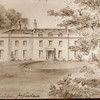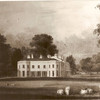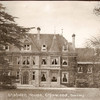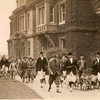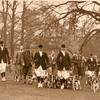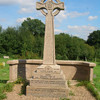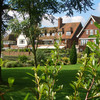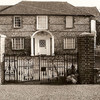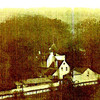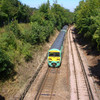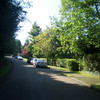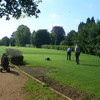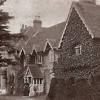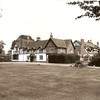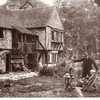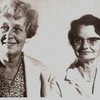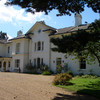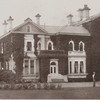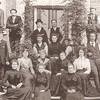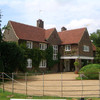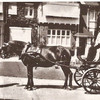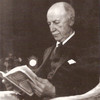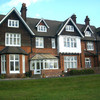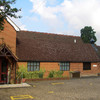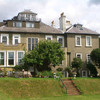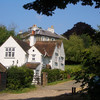The Great Estates
By the 1850’s the principal estates in Chipstead were Shabden, Eyhurst, Stagbury, Pirbright, and Reeves Rest, but in 1866 Elmore became the first of a series of large houses to be built over the following 50 years by the gentry whose principal source of income lay in a business career in London.
During this period imposing mansions with large estates were built, including Starrock Court (1868), Longshaw (1888) and Eyhurst Court (1900).
Shabden
There has been a house at Shabden on the High Road since 1263 when it was occupied by Alured de Shepindon, a family name indicating a connection with sheep.
From the 1770s Shabden was the seat of John Fanshawe, who was associated with controlling the affairs of the royal palaces. By this time Shabden was the principal mansion within the parish, with an estate of approximately 500 acres, Fanshawe having acquired Noke Farm in 1777. To John Fanshawe we owe the Long Plantation and Tickners Wood. On his death in 1816 the estate was bought by Archibald Little, a Scot, whose large marble monument can be seen in St Margaret’s Church.
The Littles were succeeded by the Cattleys in 1844. John Cattley, a Yorkshireman and a director of Royal Exchange Assurance, funded the improvement programme for St Margaret’s Church, and his son funded the enlargement of the north aisle and provided the oak seating. The Cattleys were also responsible for the transformation of Shabden House into the French Renaissance style in 1870, and for the building of Shabden Cottages to house estate staff.
Perhaps the most flamboyant occupant of Shabden was Sir Horace Brooks Marshall, who bought the estate in 1909. He was the proprietor of a large publishing company and became Lord Mayor of London in 1918/19. He was created a Baron in 1922, taking the title Baron Marshall of Chipstead. He improved the difficult bird shooting on the estate to such a high degree of excellence that the Shabden shoot achieved national recognition. Three of George V’s sons, to become the future Edward VIII, George VI and the Duke of Kent, occasionally enjoyed the sport at Shabden.
Lord Marshall died in 1936 and the Shabden estate was purchased by Surrey County Council and converted into a geriatric hospital for elderly ladies. By 1975 the Area Health Authority decided that the elderly patients who had occupied the house for nearly forty years ought to be moved to a place more in conformity with modern fire and safety regulations.
Eventually, a decision was made and in the early 1980s Shabden was sold to a developer and divided into a number of substantial individual dwellings, each of four or five bedrooms, these and the separate lodges being given a share of the extensive grounds as gardens. At the same time Shabden Cottages were sold off to individual owner-occupiers, thus ending another link with a past era.
The Marshall name lives on through the Lord Marshall Settlement, set up in 1923 to provide nursing or relief to the sick or needy in the parish of Chipstead and adjoining parishes.
Eyhurst
H65 Eyhurst Court (left), added to the Eyhurst estate in 1900 H51 Flint faced farmhouse on the Eyhurst estate, 1983
The Eyhurst estate and farm, located on the high ground between Chipstead Lane and Outwood Lane, dates from Saxon times. The name derives from the Saxon Iw Hurst, meaning a yew wood, and was a major property of Chipstead Manor. In the 1790s the Jolliffe family acquired Chipstead Manor and the Eyhurst estate, but it was subsequently sold to Thomas Alcock in 1843.
The flint faced farmhouse dates from the 18th century, and the imposing mansion of Eyhurst Court was added in 1900, becoming the Lloyds Bank Staff Training College in the 1970s. In the 1990s Eyhurst farm was sold and redeveloped as the Surrey Downs Golf Club, and Eyhurst Court was converted into luxury apartments. The gardens of Eyhurst Court were also substantially re-developed with additional blocks of luxury apartments.
Stagbury
On Outwood Lane stood Stagbury House, a delightful 18th century mansion with an estate running at the lower level along the Chipstead valley and rising up to How Lane. The house was the home of Thomas Walpole (1755-1840), son of the Hon Thomas Walpole, owner of Carshalton House from 1767 to 1782.
In the 1890s Henrietta Vade-Walpole oversaw the sale of land on the Stagbury estate to the South Eastern Railway with a view to exploiting the potential of the railway for property development, primarily aimed at wealthy City financiers. Walpole Avenue, with its substantial houses and large gardens, was laid out in 1901 and steadily developed over the next 40 years. Chipstead Golf Club, on the site of the former Doggetts Farm, was established in 1905.
Stagbury house was demolished in 1972 and replaced with a development of town houses. All that remains are the two cedar trees which once graced the garden and now dwarf the houses in Old Oak Avenue.
Pirbright Manor
Pirbright Manor in Hogscross Lane dates from 1242, and was the site of the ancient manor house of Peter de Perefrith, a local landholder. The house was rebuilt in the 16th century and became the beautiful Elizabethan building set in glorious grounds that we see today. The historic residential area at Ruffetts End was part of the Pirbright estate.
Around 1905 John Acton Garle inherited Pirbright Manor, but only held on to it for a few years. During the 1930s and 1940s Sir Walter and Lady Moberly owned the estate, and in 1948 it was sold to Helen Delmege and Theodora Turner who converted it into Fair Dene School, an independent school for girls up to the age of 11 and boys up to the age of 7.
When the school closed in 1984, the main house was converted into apartments with additional dwellings in the adjoining buildings and barn. The beautiful grounds remain today as they were when it was both a school and a country estate.
Reeves Rest
H36 Reeves Rest, High Road, in 1999 H37 Reeves Rest, High Road, in 2007
Reeves Rest was originally built in 1810 but the Regency building was added to later that century with a Victorian extension, and finally the third Edwardian extension was added. The main house consisted of 14 bedrooms and dressing rooms, 2 bathrooms, 3 reception rooms, a comfortable lounge hall and ample domestic offices. It also had two garages, stabling with men’s rooms, and cottages for the gardeners and chauffeurs.
Sir Alfred Ernest Tritton and Lady Agnetta Tritton purchased Reeves Rest in 1922 from Lord Hylton’s estate, subsequently moving to Upper Gatton in 1939. During the war Canadian soldiers stayed at the house and reportedly ruined many of its fine internal features including the stair banisters. Latterly the house was divided into three individual dwellings and the cottages and lodge all separately owned.
Elmore
Since the end of the Second World War, Elmore has been well known in Chipstead as the home of the annual Village Fair and Flower Show. The original house at Elmore was built in 1866 by Henry Butler, a prosperous wine-merchant of Fenchurch Street.
Upon Butler’s death in 1909, the property was acquired by Thomas Moss Cheesman, a London stockbroker, and his wife Eva. In 1925 the property passed to Alexander Waddell Dods, who demolished the original house in 1926 and built the present property in the style of the period.
In 1935 Norman Wates and his wife Margot (Peggy) moved to Elmore. The Wates Building Group was founded by Norman’s father in 1897 and his three sons, Norman, Ronald and Alan greatly expanded the Company by pioneering speculative house building in the 1920s and 1930s. Norman Wates died in 1969 and since then his son John and his family have been living at Elmore.
Commenting on the layout of the Elmore estate, John Wates says, “I think the land at the back of the three estates – Longshaw, Elmore and Shabden – was deliberately laid out for beating the pheasants from one end to another. There were certainly plenty of pheasants around in those days as my mother remembered well.”
Elmore is now the only large property in Chipstead to continue as a family estate.
Longshaw
One of the other main estates in Chipstead was Longshaw, which had its own dairy farm and about 30 acres of land running from Hazelwood Lane down to Outwood Lane, including Dene Farm. In the early part of the 20th century the property was owned by G H Bravington, chairman of Bravington’s, the jewellery retailers. He loved horses, and kept 20 thoroughbred horses in the stables and a pack of drag hounds in kennels at the bottom of Castle Road. Sadly, hunting with horses came to a temporary end in 1914, when all available horses were requisitioned to the Western Front.
Kenneth Stoddart acquired the estate in the 1920’s, and when he died in the 1960’s the estate was left to Surrey County Council on condition that it would be preserved as green belt land. The house then became a residential home for old ladies.
In 1964 two fields known as Gatefield and Hartfield were given to Banstead Urban District Council by Kenneth Stoddart and Norman Wates of Elmore for use as public open space and playing fields, which became Chipstead Meads.
In 1978 the Chipstead Village Preservation Society acquired Longshaw on an ambitious self financing plan which involved selling off parts of the house and estate at the same time as the purchase went through. The house was converted it into eight apartments. At the same time the stable block was sold to the Chipstead Players who subsequently converted it into the Courtyard Theatre.
Starrock Court
As the tithe map of 1847 shows, Starrock Farm was independently owned by George Harrison. This was one of the smaller farms in Chipstead, with land on both sides of Starrock Lane. The mansion of Starrock Court was added in 1868. Starrock Court is unusual in that it is almost entirely constructed of flint, on a flint foundation, the stone presumably being mined locally. Four storey accommodation for servants was added to the main house in the 1880’s.
The Ross family owned Starrock Court during World War I, and the family could observe the bombing of London by Zeppelin airship raids from the belvedere on top of the house. Sadly, the Ross family lost 3 sons and a daughter in the war, which is recorded on the war memorial on Church Green.
The north western part of Starrock Farm, bounded by High Road, Coulsdon Lane and Starrock Lane, was developed as residential housing between the wars. However, the south eastern part continues as a working farm, although the original farmhouse is now a private residence.
